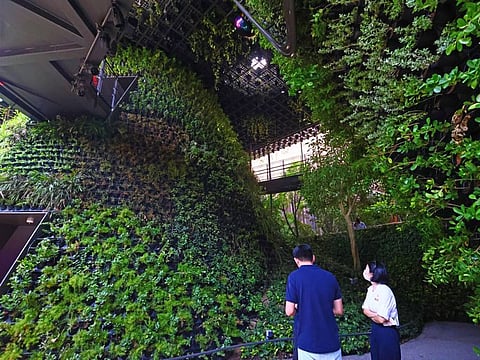Watch: Singapore shares its success story at Expo 2020 Dubai
From minimal use of electricity to greenery all around, pavilion exudes sustainability

Also In This Package
Dubai: With its lush green surroundings, the structure from the ground up, is a visual treat. Its climbing robots that monitor the health of plants, renewable source of electricity and net-zero energy architecture give the Singapore Pavilion at Expo 2020 Dubai a ‘Sustainability’ feel.
The Singapore Pavilion, with its theme ‘Nature, Nurture, Future’, is a manifestation of how the Southeast Asian country overcame its physical limitations as a small island city-state and became a highly liveable and sustainable city.
It is also very apt that the Singapore Pavilion is located in the Sustainability District, between The Netherlands and Czech Republic pavilions and just a few metres away from the Earth Plaza. Every nook and cranny of the Singapore Pavilion tells the story of “practical urban solutions for using resources, regenerating nature, building strong communities and improving the quality of life.
“Many of the design principles behind the pavilion are urban strategies used in Singapore at the city scale. The ‘Singapore Story’ introduces some of these key ideas, including the careful use of water and power; the creation of common spaces and urban connections and innovations in vertical gardens as well as waste management,” said the creators of the Singapore Pavilion.
‘Human capital’
Singapore is one of the smallest countries in the world — ranked 176th with a land area of 728.3 sq-kilometres. Apart from the small land area, Singapore also has limited resources. “But it’s not a problem — we have human capital,” Singapore Ambassador Kamal R Vaswani told Gulf News.
Vaswani said the issue of sustainability is not just a buzzword in Singapore. It was borne out of necessity. And at Singapore Pavilion — measuring only 1,550 square metres (one of the smallest pavilions at Expo 2020 Dubai) — the country’s success story of turning a limited space into a livable and thriving environment is shared.
Covered in green
The pavilion is covered in green and designed as an open structure. It can withstand the desert environment as it is enclosed by trees, shrubs, vines and hanging plants that buffer the harsh conditions. The foliage tempers the heat and keeps the moisture in, while creating a microclimate environment for plants to thrive.
Creators of the pavilion said hundreds of plant varieties were cultivated and more than 80,000 plants were used to cover the pavilion. The greens were brought mainly from Singapore and other parts of Southeast Asia and some were endemic to the UAE.
The Singapore Pavilion has no air-conditioning because it uses natural ventilation and the green architecture, aided by 51 dry-mist fans, keep the pavilion cool.
Net-zero energy pavilion
Lay Bee Yap, the Singapore Pavilion Deputy Commissioner General, said their aim was to have a self-sufficient, net-zero energy pavilion that operates on clean, renewable solar power. To do this, they have installed 517 solar panels to supply all energy needs by the pavilion while 18 sun pipes capture and send daylight from the roof-top down to the pavilion’s interiors, thereby minimising the use of electric lights.
The water used to irrigate the thousands of plants is groundwater that is desalinated with solar energy coming from the photovoltaic (PV) panels. They also employ phytoremediation or the use of soil microbes to reduce the concentrations or toxic contaminants in the environment. As for the trash or waste produced by the pavilion, they have a system called waste eco-digester.
Encouragement for visitors
The environmental showcase is aimed at encouraging visitors to contemplate their roles in protecting the environment and fostering stronger relationships between man and nature, noted Larry Ng, Singapore Pavilion Commissioner-General. He said: “As visitors experience the pavilion through its welcoming spaces, digital exhibits and programmes, we hope that they will gain new perspectives on how nature and technology can be integrated into our urban spaces and see the possibilities of how our cities can be designed to be sustainable, liveable and resilient.”
Sign up for the Daily Briefing
Get the latest news and updates straight to your inbox









